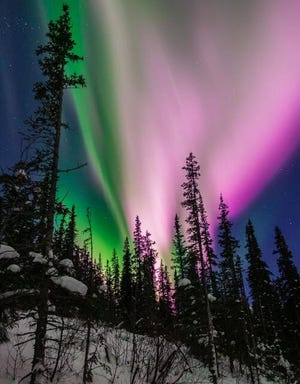List members , it all seems to be coming together lately...now here's a totally unexpected validation for the common electromagnetic cause and nature of earthquakes and "spacequakes" (they are both actually the same phenomena , one occurs above the Earth , the other inside the Earth) .
Please note that seismometers are designed to detect ground vibration i.e. they are motion sensors...then how come they are picking up Auroral fluctuations , 62 miles (100 Km) above the Earth's surface ??
What's shakin'? Earthquake sensors detect northern lights in Alaska
USA TODAY
- This is the first research to use seismometers to study the northern lights.
- Seismometers could be paired with other instruments to study these fluctuations.
- "This shows that we can still make discoveries, in this case with seismometers, to understand the aurora."
Earthquake sensors apparently don't just detect quakes – they can also detect the northern lights, a new study said.
This is the first research to use seismometers to study the northern lights (aka aurora borealis), the University of Alaska - Fairbanks said in a statement.
"I was blown away by how well you can record magnetic storms" (from the aurora) said study co-author Adam Ringler of the U.S. Geological Survey.
By comparing data collected by cameras, magnetometers and seismometers during three aurora events in Alaska in 2019, seismologists found that it's possible to match the breathtaking display of lights with seismic signals, to "observe" the same phenomenon in different ways.

“The Earth’s ground is in continual, low-level motion that is captured by seismometers,” said study lead author Carl Tape, a geophysicist at the University of Alaska - Fairbanks. “It turns out that these seismometers also capture continual influences from space weather, including during aurora displays.”
The aurora borealis, or northern lights, occurs when solar winds – plasma ejected from the sun's surface – meet the protective magnetic field that surrounds the Earth. The collision of particles produces colorful lights in the sky and creates fluctuations in the magnetic field that are sometimes called solar or space "storms."
The new study, which was published in the journal Seismological Research Letters, shows how seismometers could be paired with other instruments to study these fluctuations.
“What’s captivating for me is that a seismometer – designed to record the motion of the ground – can actually record variations arising from auroral variations seen in the Alaska night sky, emanating from 62 miles high.” Tape said. “A scientifically curious person might pause to try to understand how this could be possible, and that’s part of the goal of the work.”
The researchers noted in their paper that the link between the aurora borealis and magnetic perturbations was first discovered in Sweden in 1741, and that a seismometer in Germany detected an atmosphere-generated magnetic event for the first time during a strong solar storm in 1994, the Seisomological Society of America noted in a statement.
"People have been making these connections for 250 years," Tape said. "This shows that we can still make discoveries, in this case with seismometers, to understand the aurora."
Regards
